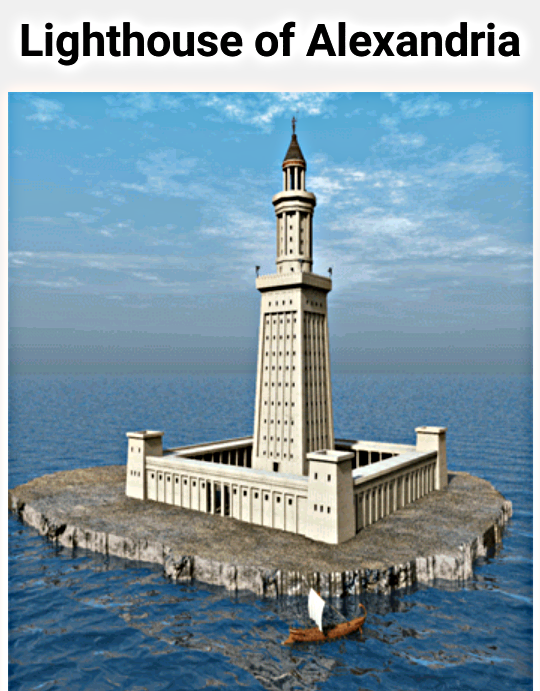Lighthouses of Alexandria

The Lighthouse of Alexandria was the first lighthouse in the world. Construction began in 290 BC and took twenty years to complete. When it was done it was the tallest building in the world at the time, except for the Great Pyramid. It was built on the island of Pharos, to help guide trade ships into its busy harbor at Alexandria, Egypt. The lighthouse was damaged by several earthquakes and eventually became an abandoned ruin. In 1994 some of the remains of the lighthouse were discovered by French archaeologists in Alexandria's Eastern Harbor.
Interesting Facts:
The Lighthouse at Alexandria is also known as the Pharos of Alexandria.
The city Alexandria was named by Alexander the Great. It was one of 17 cities that he named after himself, but Alexandria was one of the few to survive. It is still a prosperous city today.
Alexander the Great Died in 323 BC. The Lighthouse at Alexandria was built beginning in 290 BC, many years after Alexander the Great's death.
Ptolemy Soter was the ruler of Egypt who decided to build the lighthouse to guide sailors into the port.
In today's money it would have cost about three million dollars to build. In 290 BC it cost 800 talents (the form of money in this time).
It is thought to have been constructed of limestone blocks.
The lowest level of the lighthouse was 100 feet square and 240 feet high. The second level had eight sides and was about 115 feet tall. The third level was a 60 foot high cylinder that had an opening at the top to allow a space where the fire burned to light the way for sailors in the night. On top of this was a statue in honor of Poseidon, the god of the sea.
The Lighthouse at Alexandria was approximately 450 feet tall.
Inside the lighthouse there were stairs that allowed people to climb to the beacon chamber.
It was reported that there was a large mirror inside, possibly made of polished bronze. The purpose of the mirror was to project a beam of light from the reflection of the fire.
It was damaged by three earthquakes. After the last earthquake it was abandoned and fell to ruins. This allowed sailors to see the beam at night. The smoke from the fire was important during the day as it guided sailors during the day. Both the beam of light and the smoke could be seen as far as 100 miles away.
The Great Pyramid of Giza is the longest surviving of the Seven Wonders of the Ancient World. The second is the Mausoleum at Halicarnassus and the Lighthouse of Alexandria was the third longest to survive.
In 1480 the last the lighthouse's remaining stone was used to build the Citadel of Qaitbay by the sultan of Egypt Qaitbay. The citadel was built on the same island where the lighthouse once stood.
Julius Caesar mentions the Lighthouse of Alexandria in his writings.
Today the city of Alexandria uses the symbol of the lighthouse on the flag of the Alexandria Governorate as well as on their seal. It also appears on the seal of Alexandria University.